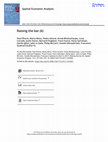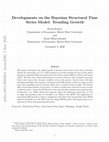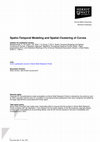Papers by Arnab Bhattacharjee

Spatial Economic Analysis, 2017
Raising the bar (6). Spatial Economic Analysis. This editorial summarizes and comments on the pap... more Raising the bar (6). Spatial Economic Analysis. This editorial summarizes and comments on the papers published in issue 12(4) so as to raise the bar in applied spatial economic research and highlight new trends. The first paper addresses the question of whether 'jobs follow people' or 'people follow jobs'. The second paper develops a new methodology to determine functional regions. The third paper is a major contribution to the growing literature on new modelling approaches and applications of disaster impact models. The fourth paper focuses on the costs and benefits of higher education. The fifth paper develops a two-step procedure to identify endogenously spatial regimes in the first step using geographically weighted regression, and to account for spatial dependence in the second step. Finally, the sixth paper estimates a dynamic spatial panel data model to explain house prices and to show that restricted housing supply in the city of Cambridge, UK, has some undesirable labour market effects. KEYWORDS labour market areas, disasters, education, house prices, spatial econometrics 摘要 提高标准(六)。Spatial Economic Analysis. 此一编辑评论概要并评析第十二期第四辑所发表的文章,从 而提高应用空间经济研究的标准,并强调崭新的趋势。第一篇文章处理有关"人随工作"或"工作随人"的 问题。第二篇文章发展定义功能区域的崭新方法。第三篇文章对于灾害影响模型的崭新模式化方法及应 用此类成长中的文献作出重大贡献。第四篇文章聚焦高等教育的成本与效益。第五篇文章发展一种指认 内生空间体制的二阶段方法:第一阶段运用地理加权的迴归,并在第二阶段考量空间依赖。最后,第六 篇文章评估动态空间面板数据模型,以解释住房价格,并展现英国剑桥城市中的有限住房供给,对于劳 动市场产生若干不利的影响。 关键词 劳动市场区域, 灾害, 教育, 住房价格, 空间计量经济学 RÉSUMÉ Hausser la barre (6). Spatial Economic Analysis. Cet éditorial cherche à résumer et commenter les articles parus dans le numéro 12(4) afin de relever la barre de la recherche économique spatiale appliquée et de souligner les nouvelles tendances. Le premier article aborde la question suivante: est-ce que 'les emplois tendent à
Spatial Economic Analysis, 2020
This editorial summarizes the papers published in issue 15(2) so as to raise the bar in applied s... more This editorial summarizes the papers published in issue 15(2) so as to raise the bar in applied spatial economic research and highlight new trends. The first paper combines a conditionally autoregressive process from the spatial statistics literature with a spatial Durbin error model from the spatial econometrics literature. The second paper feeds a multistage and multilevel data envelopment analysis with a microeconomic foundation. The third paper provides empirical evidence that Flegg's location quotient combined with a gravity model produces the most accurate interregional input-output multipliers. The fourth paper investigates the impact of inventor networks on the number of patents per capita in Brazil.

Spatial Economic Analysis, 2019
Spatial Economic Analysis is a pioneering journal dedicated to the development of theory and meth... more Spatial Economic Analysis is a pioneering journal dedicated to the development of theory and methods in spatial economic analysis. We are happy to announce that the journal's two-year impact factor increased from 1.231 in 2017 to 1.902 in 2018, its highest since the introduction of Spatial Economic Analysis in 2006. We would like to thank the authors, reviewers, editors, editorial board members, Regional Studies Association, Regional Science Association International British and Irish Section, and Taylor & Francis for their contributions to the growing reputation of the journal. This issue contains six papers contributing to the journal's mission. The first is based on Rey's (2019, in this issue) plenary talk at the Cork Meetings of the Regional Science Association International British and Irish Section in 2018. Rey examines the field of regional science from the perspective of wider developments surrounding open-source software and the rising open-science movement. In his opinion, the regional science community has benefited from two freedoms created by open software: the so-called 'free beer' freedom and the 'free as in free speech' freedom. The first means that there are no monetary costs involved in acquiring software; it is available for anybody who can download it. This holds for PySAL, the topic of Rey's paper, but also for all regional scientists who make available routines written in R, Matlab or Stata on their personal websites, journal websites (including for this journal) or on other platforms; these routines are free to the user beyond the fixed costs of software acquisition and installation. Spatial Economic Analysis has been making special efforts to encourage authors to provide their routines (Elhorst et al., 2016), and a growing number of authors are making use of these opportunities. Examples are
Operating leverage'describes the extent to which a …rm's operating costs are …xed in the short te... more Operating leverage'describes the extent to which a …rm's operating costs are …xed in the short term. Operating leverage ampli…es the earnings impact of a change in revenues; an e¤ect which is further ampli…ed by …nancial leverage and by non-proportionality in the tax system. Since the costs of adjusting capacity are likely to vary depending on the nature of the inputs, we expect to see sectoral di¤erences in operating leverage around the business cycle and, indeed, di¤erential adjustment costs underlie the distinction between cyclical and non-cyclical …rms that is popular with …nancial market practitioners. We …nd using a large data set on quoted UK companies between 1966 and 2010 that there are signi…cant di¤erences among sectors in the way it which operating leverage adjusts.
Theories of firm profitability make different predictions about the relative importance of firm, ... more Theories of firm profitability make different predictions about the relative importance of firm, industry and time specific factors. We assess, empirically, the relevance of these effects over a sixteen year period in India, as a regime of control and regulation, pre 1985, gave way to partial liberalisation between 1985 and 1991 and to more decisive liberalisation after 1991. We find that firm effects are important throughout, when rent seeking opportunities proliferated, as well as when competitive forces were enhanced by institutional change. In contrast, industry effects significantly increased after liberalisation, suggesting that industry structure matters more within competitive markets. These findings help understand the relevance of different models over different stages of liberalisation, and have important implications for both theory and policy.

Current Trends in Bayesian Methodology with Applications, 2015
Accurate estimation of demographic variables such as mortality, fertility and migrations, by age ... more Accurate estimation of demographic variables such as mortality, fertility and migrations, by age groups and regions, is important for analyses and policy. However, traditional estimates based on within cohort counts are often inaccurate, particularly when the sub-populations considered are small. We use small area Bayesian statistics to develop a model for age-specific fertility rates. In turn, such small area estimation requires accurate descriptions of spatial and cross-section dependence. The proposed methodology uses spatial clustering methods to estimate an adjacency matrix that captures such dependence more adequately. The model is then used to estimate agespecific fertility rates and total fertility rates at the regional NUTS III area level for Portugal. The paper makes important contributions to small area Bayesian statistics in a spatial domain focusing on estimation of fertility rates. The estimates obtained are more accurate and adequately represent uncertainty in the estimates, and are therefore very useful for demographic policy in Portugal.
China Economic Review, 2014
We study the impact of both microeconomic factors and the macroeconomy on the financial distress ... more We study the impact of both microeconomic factors and the macroeconomy on the financial distress of Chinese listed companies over a period of massive economic transition, 1995 to 2006. Based on an economic model of financial distress under the institutional setting of state protection against exit, and using our own firm-level measure of distress, we find important impacts of firm characteristics, macroeconomic instability and institutional factors on the hazard rate of financial distress. The results are robust to unobserved heterogeneity at the firm level, as well as those shared by firms in similar macroeconomic founding conditions. Comparison with related studies for China and other economies highlights important policy implications.
SSRN Electronic Journal, 2007
The paper is dedicated to the fond and loving memory of Chris Jensen-Butler, who died while we we... more The paper is dedicated to the fond and loving memory of Chris Jensen-Butler, who died while we were working on the paper. The authors gratefully acknowledge Jose Manauel Martins for his valuable assistance and helpful comments.
Statistics & Probability Letters, 1996
The coefficient of variation of a life distribution is no more than 1 if it belongs to the L-clas... more The coefficient of variation of a life distribution is no more than 1 if it belongs to the L-class and no less than 1 if it belongs to the L-class. However, there are nonexponential distributions in each of these classes that have coefficient of variation equal to 1.

Journal of Statistical Planning and Inference, 2011
Several omnibus tests of the proportional hazards assumption have been proposed in the literature... more Several omnibus tests of the proportional hazards assumption have been proposed in the literature. In the two-sample case, tests have also been developed against ordered alternatives like monotone hazard ratio and monotone ratio of cumulative hazards. Here we propose a natural extension of these partial orders to the case of continuous covariates. The work is motivated by applications in biomedicine and economics where covariate e¤ects often decay over lifetime. We develop tests for the proportional hazards assumption against ordered alternatives and propose a graphical method to identify the nature of departures from proportionality. The proposed tests do not make restrictive assumptions on the underlying regression model, and are applicable in the presence of multiple covariates and frailty. Small sample performance and applications to real data highlight the usefulness of the framework and methodology.
National Institute Economic Review, 2020
In a sample of newly created French …rms, the impact of an entrepreneur's education on the …rm's ... more In a sample of newly created French …rms, the impact of an entrepreneur's education on the …rm's survival varies widely depending on his previous labor market situation. While it is strongly positive for the overall population, it is much weaker or insigni…cant for entrepreneurs who were previously unemployed or poorly matched. Our theoretical entrepreneurship model shows that these di¤erences may be attributed to di¤erences in unobserved human capital for better educated entrepreneurs across di¤erent initial states in the labor market. Empirical results are consistent with the theory if employers have limited information about potential entrepreneurs'human capital.
We provide a way of representing spatial and temporal equilibria in terms of a Engle-Granger repr... more We provide a way of representing spatial and temporal equilibria in terms of a Engle-Granger representation theorem in a panel setting. We use the mean group, common correlated effects estimator plus multiple testing to provide a set of weakly cross corre

This paper investigates the added benefit of internet search data in the form of Google Trends fo... more This paper investigates the added benefit of internet search data in the form of Google Trends for nowcasting real U.S. GDP growth in real time through the lens of the mixed frequency augmented Bayesian Structural Time Series model (BSTS) of Scott and Varian (2014). We show that a large dimensional set of search terms are able to improve nowcasts before other macro data becomes available early on the quarter. Search terms with high inclusion probability have negative correlation with GDP growth, which we reason to stem from them signalling special attention likely due to expected large troughs. We further offer several improvements on the priors: we allow to shrink state variances to zero to avoid overfitting states, extend the SSVS prior to the more flexible normal-inverse-gamma prior of Ishwaran et al. (2005) which stays agnostic about the underlying model size, as well as adapt the horseshoe prior of Carvalho et al. (2010) to the BSTS. The application to nowcasting GDP growth as ...
Until recently, much effort has been devoted to the estimation of panel data regression models wi... more Until recently, much effort has been devoted to the estimation of panel data regression models without adequate attention being paid to the drivers of diffusion and interaction across cross section and spatial units. We discuss some new methodologies in this emerging area and demonstrate their use in measurement and inferences on cross section and spatial interactions. Specifically, we highlight the important distinction between spatial dependence driven by unobserved common factors and those based on a spatial weights matrix. We argue that, purely factor driven models of spatial dependence may be somewhat inadequate because of their connection with the exchangeability assumption. Limitations and potential enhancements of the existing methods are discussed, and several directions for new research are highlighted.
In a sample of newly created French …rms, the impact of an entrepreneur's education on the …rm's ... more In a sample of newly created French …rms, the impact of an entrepreneur's education on the …rm's survival varies widely depending on his previous labor market situation. While it is strongly positive for the overall population, it is much weaker or insigni…cant for entrepreneurs who were previously unemployed or poorly matched. Our theoretical entrepreneurship model shows that these di¤erences may be attributed to di¤erences in unobserved human capital for better educated entrepreneurs across di¤erent initial states in the labor market. Empirical results are consistent with the theory if employers have limited information about potential entrepreneurs'human capital.

Econometrics, 2005
This paper considers empirical work relating to models of firm dynamics. We show that a hazard re... more This paper considers empirical work relating to models of firm dynamics. We show that a hazard regression model for firm exits, with a modification to accommodate age-varying covariate effects, provides an empirical framework accommodating many of the features of interest in studies on firm dynamics. Modelling implications of some of the popular theoretical models are considered and a set of empirical procedures for verifying testable implications of the theoretical models are proposed. The proposed hazard regression models can accommodate negative effects of initial size that go to zero with age (active learning model), negative initial size effects that fall with age but stay permanently negative (passive learning model), conditional and unconditional hazard rates that decrease with age at higher ages, and adverse effects of macroeconomic shocks that decrease with age of the firm. The methods are illustrated using data on quoted UK firms. Consistent with the active learning model,...

Over the last two decades central bank independence has become the default for the conduct of mon... more Over the last two decades central bank independence has become the default for the conduct of monetary policy. In turn the decisionmaking process, within a central bank, has become by design much more transparent. The governance of this process is generally embedded in some type of committee. In turn, the use of committees to make decisions about interest rates, and other aspects of monetary policy, has increased the amount of information again deliberately made available about this decision-making itself. This in turn has generated a large literature on how committees make decisions, how they interact among themselves, and whether or not the outcome reects the consensus, a majority decision, or perhaps the domination of one or more members of the committee in the decision-making process. This paper o¤ers further insight into how decisions are made within a committee and and proposes a method by which we can detect hidden interactions among members of a committee, once weve con...
We compare three methods of motivating money in New Keynesian DSGE Models: Money-in-the-utility f... more We compare three methods of motivating money in New Keynesian DSGE Models: Money-in-the-utility function, shopping time and cash-in-advance constraint, as well as two ways of modelling monetary policy, interest rate feedback rule and money growth rules. We use impulse response analysis, and a set of econometric distance measures based on comparing model and data variance-covariance matrices to compare the different models. We find all models closed by an estimated interest rate feedback rule imply counter-cyclical policy and inflation rates, which is at odds with the data. This problem is robust to the introduction of demand side shocks, but is not a feature of models closed by an estimated money growth rule. Drawing on our econometric analysis, we argue that the cash-in-advance model, closed by a money growth rule, comes closest to the data

It is important for demographic analyses and policy-making to obtain accurate models of spatial d... more It is important for demographic analyses and policy-making to obtain accurate models of spatial diffusion, so that policy experiments can reflect endogenous spatial spillovers appropriately. Likewise, it is important to obtain accurate estimates and forecasts of demographic variables such as age-specific fertility rates, by regions and over time, as well as the uncertainty associated with such estimation. Here, we consider Bayesian hierarchical models with separable spatio-temporal dependence structure that can be estimated by borrowing strength from neighbouring regions and all years. Further, we do not consider the adjacency structure as a given, but rather as an object of inference. For this purpose, we use the local similarity of temporal patterns by developing a spatial clustering model based on Bayesian nonparametric smoothing techniques. The Bayesian inference provides the uncertainty associated with the clustering configurations which is typically lacking in classical analys...




Uploads
Papers by Arnab Bhattacharjee